Auzen X-Fi HomeTheater HD and Auzen OPAMPs Review

Expected and unexpected from Auzentech: we are going to talk about the sound quality and features provided by X-Fi HomeTheater HD sound card and fifteen operational amplifiers.
After a number of postponements I had mentioned in my earlier review, the Auzen X-Fi Home Theater sound card finally made it to the market in September 2009. The manufacturer first posted the news that it could be preordered and then the upgrade program for owners of X-Fi Prelude 7.1 and X-Meridian 7.1 took off. When the long-anticipated product came out, I had some serious doubts about whether it needed a comprehensive review since it looked the same as the Auzen X-Fi Forte 7.1 with an added audio-over-HDMI capability. Well, I have to confess now that my suspicions were not well grounded.
So, what are the key benefits of the Auzen X-Fi Forte HomeTheater HD sound card which comes at a recommended price of $250 and who is it intended for? If you’ve got an Auzen X-Fi Prelude 7.1 and have paid a lot of money for the joy of listening to your favorite music in highest quality, does it make sense to give it back for only $50 under the upgrade program conditions? I will try to give you the answer in this review but will put off the test of this sound card with high-definition formats (Dolby® TrueHD and DTS-HD Master Audio) until a future report. First, I will tell you a few words about the purpose the X-Fi Forte HomeTheater HD was designed to fulfill.
World Conspiracy and Protected Path
As digital video sources like DVD and SACD developed, the popular SCART interface was replaced with the more compact digital interface HDMI that had been originally designed to transfer video content with a resolution of 1920×1080 pixels and a refresh rate of 60 Hz along with eight-channel audio in 192 kHz/ 24 bits format. For many years the new High-Definition Multimedia Interface was penetrating the market, being implemented in more and more audio/video devices. In its new specification HDMI reached game consoles and PCs but it is only in the fall of 2009 that users got the opportunity to play Blu-ray discs on the PC without any quality loss.
When developing the Blu-ray disc specification, the members of the Blu-ray Disc Association focused on copy protection technologies and agreed to ensure maximum security throughout the entire data path, from the medium to the display device. Thus, the contents of a disc are encrypted with AACS and data are transferred using HDCP. If at least one device in the chain does not support HDCP, i.e. does not guarantee copy protection, the transfer is blocked or the quality of video and audio is forced down to the level of ordinary DVD.
However, when a Blu-ray disc is being reproduced not by a hardware player but by a PC, this protection system turns out to have a gap in the operating system and its applications. Prior to Windows Vista, there had been no guarantee for the protected content to pass through the computer without being intercepted. Thus, there had been no opportunity to reproduce Blu-ray in full quality despite the HDCP support implemented in monitors and graphics cards.
Microsoft solved the issue by introducing a protected audio/video path (PAVP) into its operating systems. It is an encrypted channel for transferring data into graphics and sound cards. If supported by software (device driver, disk player), the protected content is delivered safely to the hardware which decrypts the data stream and passes it on to HDCP. Being among the first to implement PAVP into its integrated graphics cores, Intel claims that that technology not only protects data but also lowers the CPU load by performing all HD video decoding on the graphics card. This is the visual aspect of that technology. What about audio?
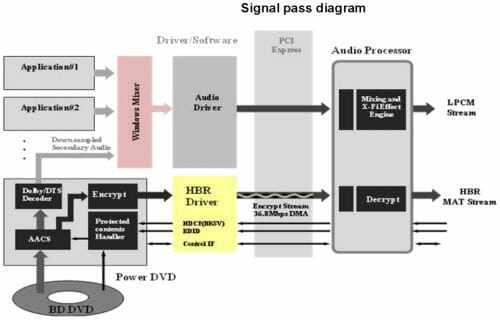
At first, there were no PAVP-compatible sound devices for the PC. PAVP was not supported even by Intel chipsets which had long been able to transfer multichannel 192kHz audio over HDMI while many discrete graphics cards with HDMI output were limited to the capabilities of the outdated SPDIF.
Auzentech was ahead of other developers to announce, in the summer of 2008, the capability to reproduce high-definition audio formats on the PC, but spent a whole year polishing its product off. Over this period, ASUS, AMD, Realtek and VIA offered the same functionality in their products and Auzentech lost its leading position. However, a sound card is not only about playing Blu-ray discs, so other factors must be considered as well.
Features, Specifications, PCB Design
This sound card was originally called Home Theater 7.1. However, the main opponent not only had released a similar product one year earlier, but also given it a self-descriptive name. The ASUS Xonar HDAV1.3 can process video and transmit audio data in high-definition formats. I guess that every computer user will easily spell out the letters HDAV as High Definition Audio Video since those letters have been used extensively in product names over the last few years. The original name selected by Auzentech did not tell anything to the potential buyer, so the trivial numbers 7.1 in the name were replaced with the letters HD. They mean that the Home Theater has an HDMI interface and can work with high-definition audio formats.
What are the differences between the competing products from these two brands? I checked out at the comparison section on the Auzentech website but could not find recent ASUS cards there, although the Auzentech product range is represented in full. Instead, I found a curious table there. According to it, four Auzen sound cards are good for music but, for some mysterious reasons, not equal when it comes to movies.
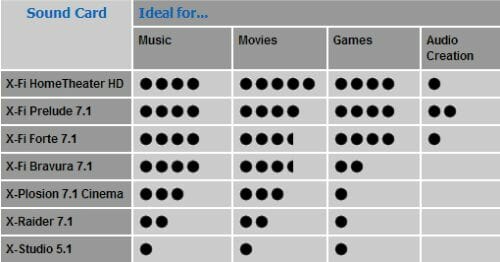
Well, let’s put all this marketing aside and try to figure everything out ourselves by looking at the card and its specs.
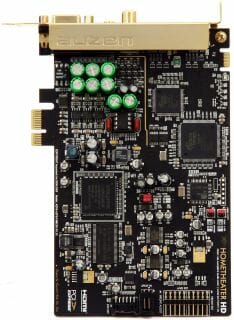
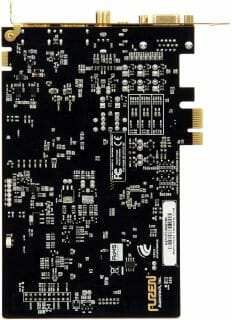
As I wrote earlier, the HomeTheater HD is almost the same as the Forte 7.1 from a functional point of view. That is, it implements the same capabilities and sports the same exclusive technologies. Additionally, it has HDMI connectors and a chipset for processing a digital audio/video stream. The card has grown to maximum possible height, providing the opportunity for a more rational component layout of its analog section. Particularly, there is no obstacle now to installing adaptors with a couple of opamps in metal TO-99 cases.
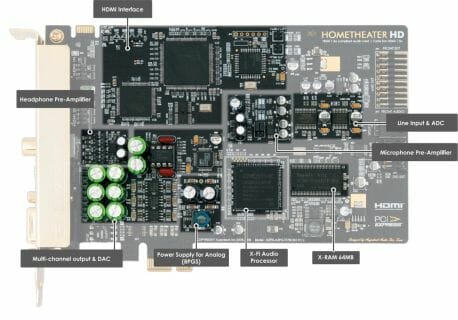
An AK4396 DAC has vanished from the PCB and the four stereo outputs of the CS4382 are all used now. That’s not a big loss as it was nearly impossible to tell these converters apart aurally with the Auzen Forte 7.1. On the other hand, the Auzen Prelude 7.1 had a much better sound than the Auzen Forte 7.1 despite having the same DAC, so you shouldn’t come to any conclusions as yet.
I could find no other changes in the electronics or drivers except that, besides supporting balanced microphones and allowing to record from two microphones simultaneously, the new sound card claims to be able to record audio from the HDMI input. I did not have the opportunity to check this function out practically, though.
I don’t know if the ASUS HDAV1.3 can record sound from HDMI, either, but ASUS cards have been definitely inferior to the latest Auzen products in working with microphones. I covered this issue in my Auzen X-Fi Forte 7.1 review. Instead, the Xonar offers not only a digital output but also a digital input. Auzen implements a dedicated output with a headphone amplifier whereas ASUS offers a video enhancement feature. So, every card has some strong points and I will just show you the following table that compares the capabilities of these two products.
It looks like choosing between the two depends on what functionality you need, the price factor being of secondary importance. For example, the Auzen X-Fi HomeTheater HD is currently somewhat cheaper than the ASUS Xonar HDAV1.3 Deluxe which provides a multichannel analog output as well, but you need a PowerDVD Ultra license ($90 with a discount included) in order to play Blu-ray discs and output HD audio via HDMI whereas ASUS provides its users the ArcSoft TotalMedia Theater player for free. Besides, the HDAV1.3 costs about $50 less without the H6 expansion card and its Slim version is even some $100 cheaper. The Slim version of the Xonar HDAV has no analog inputs and outputs at the back panel (but supports the Front Audio connectors of a system case) and will best suit a cinema lover who owns a serious stationary audio system and does not need his computer to produce highest-quality sound via headphones. Headphone support is one of the trumps of Auzen.

Besides the inputs and outputs we are familiar with by the Auzen Forte 7.1 card, the HomeTheater HD has two HDMI connectors, one of which receives the graphics card’s signal and another transmits it further together with audio. The sound card also has an internal HDMI input implemented as a header for a flexible cable like the one you use to connect graphics cards in SLI or CrossFireX mode. The documentation says that that header is a future-reserved feature as yet.
Package and Accessories, Testbed and Installation
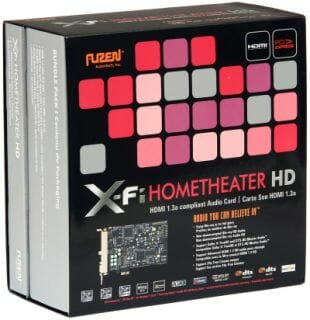
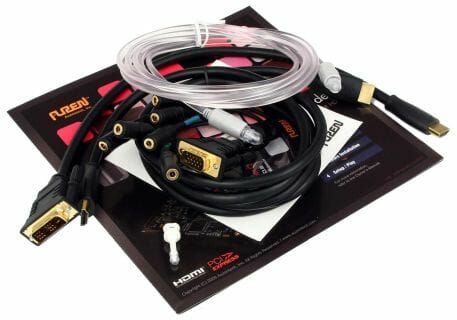
The box with an Auzen X-Fi HomeTheater HD consists of two individual compartments that contain the card and its accessories including a lot of connecting cables:
- One HDMI-HDMI cable (2 meters long)
- One short DVI-HDMI cable
- One optical cable with an additional RCA-TOSLINK adapter (2 meters)
- Analog adapter from D-Sub to six mini-jack connectors
I guess this selection of cables is going to be enough for most users. I also like the packaging: the two individual compartments with a common wrapper are handier than the composite cardboard structures inside the tall boxes of the earlier Auzentech products.
Besides an illustrated installation guide in six languages, there is a small brochure in the box for you to learn about the exceptional benefits of PowerDVD 9 Ultra.
As I am not going to test the transmission of multichannel HD audio, which is available in Windows Vista or 7 only, I will use the same old testbed as in all my previous tests.
The testbed is configured like follows:
- Mainboard: ASUS A8R-MVP (Radeon Xpress 200 chipset)
- CPU: dual-core AMD Opteron 165 (@ 2.7 GHz)
- System memory: Corsair CMXP-3200XL 2 GB
- Graphics card: Gainward Bliss 9800GTX
- Hard disk drives: Samsung SpinPoint S250 and Hitachi Deskstar T7K250 (SATA)
- Optical drives: Plextor Premium and BENQ DW1640
- Sound card: ASUS Xonar D2 (PCI)
- Power supply: Rosewill Turbo Series RT550-135-BK
- Microsoft Windows XP SP3
The software from the included disc installed in the same way as with the Auzen Forte, but not that successfully. No compatible sound card was identified at first. The problem was solved by means of a patch downloaded from the Auzentech website. Then I began my tests but quickly found a strange noisiness of the sound card’s analog output. Could it be some defect? No, it was only due to the enabled FP_Microphone monitoring which translated the noise from the microphone input directly to the output. The integrated microphone amplifiers in this sound card are not as high quality as to eliminate all noise. The input/output settings for each of the card’s operation modes (Entertainment, Game, Audio Creation) are stored individually, so don’t be surprised if you hear the hiss again when you switch, for example, into the game mode.
The Windows XP software for the Auzen HomeTheater HD looks and works the same as with other products based on the X-Fi audio processor. For example, the screenshot below shows the control console in Audio Creation mode. The single difference from the Auzen Forte console is an added fourth column called HDMI-In and a new recording source (called HDMI-In as well) in the Recorder section.
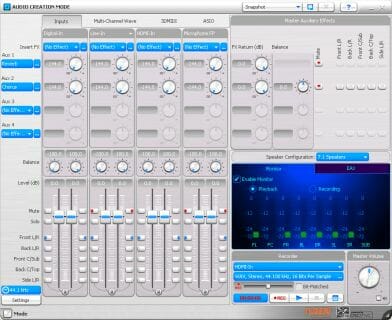
Theoretically, each column in this section means that the input can be used individually (in parallel to the others) but the HDMI input is not yet supported by ASIO, so we have to rely on Windows Vista/7 that can take the sound card apart into its components and use them simultaneously.
Input channels:
- channel: 0 (Mix FL) — Int32LSB
- channel: 1 (Mix FR) — Int32LSB
- channel: 2 (Mix RL) — Int32LSB
- channel: 3 (Mix RR) — Int32LSB
- channel: 4 (Mix FC) — Int32LSB
- channel: 5 (Mix LFE) — Int32LSB
- channel: 6 (Mix RC or SL) — Int32LSB
- channel: 7 (Mix RC or SR) — Int32LSB
- channel: 8 (Line /Mic /Aux L) — Int32LSB
- channel: 9 (Line /Mic /Aux R) — Int32LSB
- channel: 10 (Digital-In L) — Int32LSB
- channel: 11 (Digital-In R) — Int32LSB
- channel: 12 (Mic In L) — Int32LSB
- channel: 13 (Mic In R) — Int32LSB
I could find no other defects, errors or oddities about this sound card. Everything works just as it is meant to. To check out the HDMI interface, I connected the card to a TV-set with the included cable and watched a couple of movies. The Auzen HomeTheater won’t reproduce audio over HDMI without video, so you must connect it to your graphics card and enable a secondary display (at least in the desktop extension mode) in the latter’s settings.
First Impressions and Some Theory
I had some prejudices and even fears about the Auzen HomeTheater as I had used to have a headache from the hard sound of the Auzen Forte. Although I had eventually got accustomed to that “special effect”, I still had some unpleasant reminiscences. Music shouldn’t provoke a headache after all. To my greatest surprise, I did not have anything like that with the HomeTheater. Its sound was comfortable right from the start and the change of sound over time (the notorious warm-up effect) was far less conspicuous. After about a month of working at my computer daily, I noticed the sound to have become more subtle and detailed.
The second important difference of the HomeTheater from the Forte is that any opamps sound good with it. This had been the case with the Auzen X-Fi Prelude 7.1 and ASUS Xonar Essence STX but not with the Auzen X-Fi Forte 7.1 where the default LME49720 sounded bad in my tests but the replacement OPA2132P was even worse. The HomeTheater comes with the same opamp as the Forte, but sounds good with it and even better with other opamp models. This sound card lacks a well-defined voice of its own. That is, the resulting sound is largely determined by the opamp you install, therefore the Auzentech modules provided for the tests came in most handy. I spent a few months listening to diverse music with each of them and writing down my impressions. The continuing warming-up of the card was improving its sound, which made me correct my evaluations of many opamps over the course of the tests.
By the way, this sound card does not get as hot as the low-profile Forte. You cannot scorch your fingers on it. This must be due to the larger PCB whose metallization layers dissipate the heat from the power converter and headphone amplifier. On the other hand, this makes the other electronic components on the card hotter whereas heat is known to be the main limiting factor of the service life of electrolytic capacitors such as those you can see on the card. These are not the hardy solid-state capacitors but ordinary aluminum ones of the “civil” grade with a max case temperature of 85°C. That’s why I have doubts as to how long a Forte might last until the electrolyte begins to dry out in its capacitors. The HomeTheater is safer in this respect as you can easily touch even the hottest capacitors of its power converter without risking to get scorched.
There arose the same problem as with the Auzen X-Fi Forte 7.1 when I tried to measure the card’s characteristics objectively. There was a high level of noise when I used an external device with top-class ADCs. I guess it must be due to the power converter. And if I used the card’s own line input, the result was limited to the quality of the integrated WM8775 converter and no different from the result of the Forte.
Listening to those numerous opamps demanded a lot of time, even without accounting for the mentioned change in sound over time which introduced its inaccuracies. Comparing a pair of opamps takes a few hours because you cannot instantly replace them whereas the long-term sound memory of humans is not perfect. Besides listening to various genres of music, alternating the chips, I had to recheck my impressions because your subjective impression depends on your general state and mood and how tired your hearing is. So, I had to think of some trick to make the testing easier.
To remind you, my tests of the Auzen Forte 7.1 did not reveal any serious difference between the front output based on an AK4396 DAC and the rear/side outputs based on a CS4382A, despite the different opamps. The analog outputs of the Auzen HomeTheater HD are all serviced by one converter CS4382A and the difference boils down to the impossibility of easy replacement of the soldered-in NJM4580 opamps. If so, why not take the rear channels as the reference point?
In the Audio Creation mode the X-Fi chip allows sending audio to any of the four outputs or to all of them simultaneously. And switching the connecting cable takes a couple of seconds only. This made the testing easier and I compared the opamps again to correct my previous impressions. The NJM4580 turned out to be not as bad as its reputation. It yields correct imaging, i.e. the musical instruments are stationary in their locations throughout the width and depth of the sound scene and are perceived coherently with the reverberations produced. Not all of the tested opamps could boast that, particularly the default LME49720 in the front output.
But why, if the LME49720 is specified to be no different from the LM4562 which produced excellent imaging in the Auzen Prelude? To make things clear I took the opamp out of my Prelude and put it into the HomeTheater. Cross-checking the three chips (the third one was the NJM4580) left no doubt in me: the LME49720 was definitely different from the LM4562 although some similarity did exist. What does it mean then?
Same-type chips produced at different times and, probably, on different production facilities may vary in their audible characteristics. I guess this must be due to a difference in the input capacitance of the opamps. Take note that National Semiconductor does not even specify the input capacitance in its product documentation. My supposition is confirmed by the fact that the characteristic flattening of the sound scene could be observed with opamps that had field-effect input transistors. For such transistors, the nonlinearity of input capacitance is more important. Opamps with bipolar input transistors (AD826, NE5532, and NJM4580) were absolutely free from that problem. The distortions caused by the nonlinearity of the input capacitance are usually eliminated by equaling the input impedances, but are there any conditions for them to be unequal?
Output Filter Topology
Besides the useful sound signal, a digital-to-analog converter produces wide-range ultrasound noise that puts an additional load on the subsequent amplification cascades and can worsen the quality of sound. Therefore, the analog section of each sound-reproducing electronic device must contain a low-pass output filter. This filter is often referred to as smoothing. It is usually based on an operation amplifier and largely determines the resulting sound of the device. A lot of unexpected nuances have to be accounted for while designing such a filter.
In my Auzen Forte review I quoted a mysterious phrase about the improved design of the output filters. It goes like this: “We have also accurately designed the DAC filter to minimize phase changes.” The following phrase (“Metalized Film Capacitors take full advantage of the superiority of a Film capacitor while minimizing inductance, and are used for the Front channel’s DAC filter.”) indicates that the engineers indeed focused on improving the characteristics of the filter. But what exactly did they improve? And what is this filter like? Let’s read through the documentation on the digital-to-analog converter CS4382A.
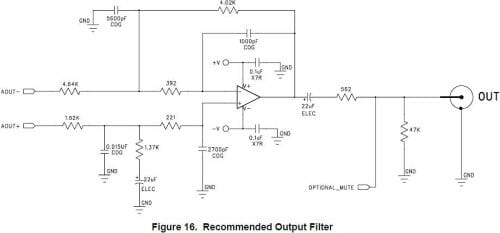
Take note of the odd discrepancy between the ratings of the passive components (resistors and capacitors). The documentation (page 9 here and page 12 here, for example) says that this design levels out the AC load on the positive and negative differential outputs of the DAC. In the more traditional design with identical resistor ratings the AC load proves to be asymmetrical.
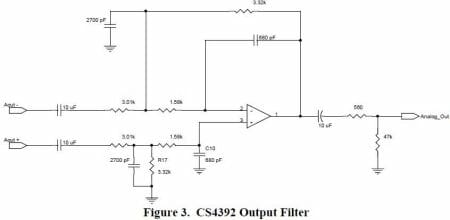
So, I suppose that the nonsymmetrical load on the DAC outputs may affect the resulting sound quality, but this solution is not good for an operation amplifier.
There are other variants of such filters. One of them is shown in my ASUS Xonar Essence STX review and below is the recommendation of AKM engineers.
Auzentech developers may have not used the recommended design. At least, there are only two electrolytic capacitors near each output connector on the PCB rather than four or six as described in the recommended designs. That is, the constant voltage from the converters’ outputs is applied to the inputs of the opamps, which may produce sudden variations in sound, too.
Thus, there may be lots of reasons for opamps to behave differently in different sound cards. And now I will tell you what is best for the Auzen HomeTheater.
Choosing Your Opamp
I’ve got a long list of opamps today. Besides the popular models I used in earlier reviews, I’ve got seven opamps from Auzentech. Unfortunately, they did not send me a module with highly promising AD797 opamps but instead I received LME49710 opamps which were not even mentioned at the manufacturer’s website.
As usual, I listened to all music material in Grado SR 325i headphones using a C.E.C. HD53R-80 amplifier. The recordings (in FLAC, APE and WAV formats) were reproduced with the foobar2000 0.9.6.9 player using the foo_out_asio 1.2.7 plugin. Audio CDs were reproduced with the PlexTools 2.36 disc player. I used diverse musical material, from special audiophile recordings to engaging albums of such performers as Robert Plant (Manic Nirvana), Manfred Mann’s Earth Band (Nightingales and Bombers), Rainbow (Bent Out Of Shape), Queensryche (American Soldier), Evanescence (Anywhere But Home), Pinetop Perkins (Born In The Delta). I also used a piece of classical music (Rimsky-Korsakov’s Scheherazade performed by Chicago Symphony Orchestra).
For you to understand my subjective evaluations, here are the definitions of the terms I will use in the description.Resolution is the ability of the sound card to reproduce clearly all the sound sources in a sound scene. A high-resolution card can “draw” the sounding objects against a dark background so that the objects do not get fuzzy or intermingle. The resolution is lacking if you don’t feel the distance to the sounding objects.
Lack of depth versus flat scene. In the former case, all the objects are too close to the listener but the resolution is not poor since you can tell that the objects are at a different distance from you. In the latter case, the objects all merge into a solid wall of sounds and there is no resolution at all.
Transparency is one more constituent of high resolution. Sounds and echoes do not merge together. There is always a perceivable layer of air between sound sources.
Coloring, particularly of vocals, is the addition of unnatural or irritating intonations to the timbre. Coloring often provokes a desire to switch the sound off but never to make it louder.
Tonal balance is the perception of the total volume of all the objects sounding at different frequencies. Comparing the tonal balance by quickly switching sound sources allows to easily discover a coloring as it makes a certain range of frequencies stand out above the rest.
Micro-dynamics is the sound card’s ability to reproduce the quietest sounds and reverberations in all detail. For example, a struck string is going to get quieter and quieter, but its timbre must remain the same until its sound goes out completely.
Detailedness, as opposed to micro-dynamics, does not tell anything about how natural the quiet sounds are. Some sounds can be heard but you won’t know their origin.
I will be mentioning Queensryche quite a lot throughout the description of the opamps because the music of this band, combining hard guitar riffs with stereo effects, proved to be unexpectedly difficult to reproduce. Many opamps that cope well with other genres of music fail at this task and produce annoying artifacts. I might have disregarded this as a poor quality of the recording itself, but there are some chips that play it perfectly: elegantly, bravely, pensively, depending on the context.
The number in the brackets is my subjective evaluation of the capabilities of the opamp to reproduce music beautifully. The grades go from 1 (worst) to 5 (best). To get the best grade the opamp has to show something exceptional in one genre of music or be an all-purpose device that is good at playing any genre. The plus and minus signs added to the grade are meant to add more gradations to differentiate between good and very good opamps since even the worst opamp in this test session is actually no worse than 4. None of them is without downsides, but none has fatal problems, either.
NJM4580 (4) introduces minor distortions at medium and high frequencies which worsen the sound of violins. Its bass is rather thin but trenchant and it has excellent dynamics and depth*, but the resolution is rather poor. However, this opamp was good at playing Queensryche.
LME49720NA (4+) produces a more detailed sound with a clear middle, shallow bass and blurred treble. Its sound scene is flat, lacking reverberations. With the integrated amplifier the scene is deeper, the sound is more energetic, the vocals are colored less, and the bass is more realistic, but the CEC yields a richer sound, especially when reproducing a piano. Queensryche sounds good on this opamp.
LME49710MA (4+) is rich, precise and epic. It is clearer, with higher resolution and more dynamics than the previous chip. It has sharper but somewhat synthetic high frequencies and scrambled echoes. The integrated amplifier is inferior to the external one in bass saturation as well as scene depth and transparency. Queensryche would be very good if it were not for the unpleasantly ringing high frequencies.
LME49710HA (5-) is good with echoes and sounds softer but less spacious. It has a coloring of the top middle. Being very detailed at medium frequencies, it becomes no better than the 49720NA in this respect at high ones. It delivers a strong bass with the integrated amplifier which is even superior to the external one in micro-dynamics. Queensryche is rather good.
LME49860 (5) is exceptionally detailed, particularly at high frequencies. It produces splendid vocals and features a rich and nonaggressive sound. The only downside is its bass which lacks hardness. Queensryche is good, the integrated amplifier is near perfect.
LM4562NA (4+) features a deep and rather sharp bottom register of drums, but bass guitars are muddy. This opamp features a high resolution, a clear middle and too accented high frequencies. The integrated amplifier sounds more vigorous and emphasizes the high frequencies in a different way, being more transparent and realistic in terms of vocals, but inferior to the external amplifier in terms of bass and scene depth. Queensryche is good.
LM6172IN (5-) has a wonderfully transparent sound, clear high frequencies and excellent vocals. Its bass is soft and not excessive**. It lacks depth and detail with the integrated amplifier. With the external amplifier it lacks dynamics and Queensryche sounds less energetic. This opamp suits best for jazz and other live recordings.
AD826 (5-) has a vigorous but not aggressive sound with a good resolution. Its bass is lead-heavy but detailed and its top frequencies are rather clear. However, its vocals are not realistic and there are minor distortions at medium and top frequencies. There are more of them with the integrated amplifier but its sound is more detailed and sharp. Queensryche is good with this opamp.
AD823 (5-) is energetic, collected and transparent. It has everything in just the necessary measure, except that it often lacks a depth of the sound scene. The medium frequencies are clear but the high ones are grainy. The sound of the integrated amplifier is hollow and unnatural. Queensryche is good.
AD8620 (4) is high-resolution and detailed throughout the entire frequency range but produces a shallow and narrow scene. This opamp has a good total balance, realistic vocals, and very clear medium frequencies. With the external amplifier the treble is hissy. The sound is more realistic with the integrated amplifier but there are more distortions as well. It is also occasionally too aggressive.
OPA627AU (4+) is rich in overtones and drive, but also booming sound, reduced resolution and cut reverberations . The highs are moved to the background, the mids are obscured at low volume and aggressive at high volume, but Queensryche is good. This opamp is almost the same as the 4580 tonally.
OPA627SM (4+) offers a good resolution at medium frequencies, but has fuzzy highs, rather booming bass and a flat scene. It loses dynamics, resolution and timbre clarity with the integrated amplifier but may be good for low-quality recordings.
OPA637AU (5-) has soft and detailed high frequencies with a specific “frost”. There is a slight accent on the top middle as if adding transparency. The sound scene is specific, as if shifted away from the listener. This opamp features a high resolution and good drive, but is somewhat lazy at reproducing Queensryche, perhaps due to the undersaturated bottom register.
OPA637SM (5) is exceptionally detailed and features a very high resolution and clear high frequencies. Its sound is soft, even somewhat too soft. The top-medium frequencies have a slight coloring with the external amplifier. The integrated amplifier produces a dull bass. Queensryche is very good.
OPA2132P (5-) is highly detailed and dynamic. It features a clear middle, a well-defined, “wooden” bass. There is a specific accent on high frequencies and a certain lack of depth, but the spaciousness can be felt fully. The integrated amplifier worsens the resolution and adds coloring to medium frequencies. It is very good for classics but not quite pleasant at rock recordings.
NE5532P (4+) produces a voluminous and brave sound with good transparency but without smallest details. It has a heavy, low-detail bass, realistic vocals, a characteristic oversaturation of high frequencies and dirt in the most intensive sections of a phonogram. It sounds surprisingly good with the integrated amplifier: the somewhat suppressed middle is comfortable but, occasionally, not as emphatic as with the other opamps.
*The rear and side outputs differed slightly in the depth of scene and the reproduction of high frequencies.
**Two samples purchased together differed in tonal balance and resolution.
The results are rather interesting, as you can see. The exclusive OPA637SM in metal armor did not win easily. It could only make it to the top when I listened to the Perkins disc. It is also at the end of my tests that I had to lower the mark of the LM4562. It had contended for a top place (a little lower than the maximum due to the accented high frequencies) and had done well at concert recordings and classics and some rock recordings, but proved to be less good at reproducing pop music. By the way, it was the old LM4562NA with a light-gray marking. I also have to note that its performance was affected by the interconnect cable and this opamp shines when united with Moster Standard Interlink 200. Interestingly, the LME49860 is superior to all other chips of the same series although formally differs from them only with the maximum voltage. It turns out that the most expensive versions of chips in a series indeed have better sound properties.
The popular NJM4580, which is recommended by its maker for audio applications, is surprisingly similar to such famous devices as the OPA627 and only differs from the highly expensive OPA637SM with a lower resolution, higher distortions and a shallower bass, but not in tonality or imaging. The old NE5532 also did well, proving to be suitable for all music genres and delivering rather high sound quality at low volume. With the integrated headphones amplifier it was one of the best in the tests.
By the way, the replaceable opamp panel on my HomeTheater passed through a number of replacements whereas the similar panel on a Forte card had lost its tight contact after I had installed a module from Auzen with cylindrical pins of a rather large diameter into it. After that adapter, I had to bend the legs of ordinary DIP-packaged chips a little so that they could hold firmly in the socket.
Sound Summary
The integrated headphone amplifier has not changed since the Auzen Forte, so I did not measure it again under load. I did check it out aurally, though. This amplifier consists of a dual-channel opamp NJM4580 and eight transistors. It does not have coupling capacitors at the outputs and features very low distortions even at a load of 32 Ohms. In my previous review I could not fully examine its sound properties because of the bizarre sound of the line output the amplifier received the signal from. This time the situation is more favorable as the line output sounds perfect and cannot be a limitation. So what can the amplifier do?
So, when I installed the Auzen HomeTheater and replaced its default LME49720 with an LM6172, the integrated headphone amplifier was definitely inferior to the C.E.C. HD53R-80 in transparency and detailedness during the first month. But it improved suddenly in the course of my opamp tests and even surpassed the C.E.C. in many respects, proving to have a better resolution, a lower coloring of vocals, a more detailed treble and more realistic bass. However, all of this was often negated by one important factor – dynamics.
As long as there is a calm intro or a barely compressed live recording, everything is perfect. But as soon as there is some action like a tumult of guitar and drums, let alone an emotional outburst of a whole orchestra, the integrated amplifier finds itself lacking power and the C.E.C. leaves a much better impression. The reason is simple: the integrated amplifier doesn’t have that much electric power. The C.E.C. has an almost 50-watt transformer and many thousands of microfarads of smoothing capacitances whereas the Auzen amplifier has but a tiny coil, two 470µF capacitors and the slim conductors of the printed circuit board.
It is a shame that the potential of the amplifier designed by Auzentech is still not fully unlocked. It is only in high-sensitivity headphones that you will be able to enjoy it since such headphones do not require much power to develop a high sound pressure. On the other hand, the “free” amplifier of the Auzen HomeTheater card has a very clear sound even with low-impedance headphones and you don’t often have this clarity even with external amplifiers. It introduces very little distortions of its own, so those opamps that are best with the external amplifier are also best with the internal one, with a few exceptions due to an unlucky superimposition of the opamp’s peculiarities with the amplifier’s ones. For example, the integrated amplifier produced a less saturated bass in comparison with the C.E.C. and worked better with bass-oriented and detailed opamps such as the LME49860NA and LME49710HA.
The Auzen HomeTheater driver is incompatible with the Auzen Prelude one, so I had to compare the card’s line output with the front output of the ASUS Xonar D2 card, having replaced its default pair of NJM2114 opamps with AD8066 ones. This modification eliminated an unpleasant coloring of medium frequencies and increased resolution but did not push the card up to a new level of performance. Using the same opamps (LM4562), the Auzen HomeTheater HD had less mud in high frequencies and, in some cases, even in the medium frequency range. The Auzen also boasts an impressively detailed bass that takes your breath away with the 2004 year concert of Evanescence. As opposed to it, the Xonar D2 has an insufficiently sharp, rubber-like bass. The ASUS card is superior to the Auzen in dynamics and, somewhat, in detail and resolution, but the Auzen delivers an overall more consistent sound scenery, immersing you into the music and making you forget about everything else as you are listening to each sound and dancing to the rhythm.
Replacing the LM4562 with an LM6172 adds realism to the high frequencies and enlivens the medium ones but makes the low frequencies muddy. When replaced with an OPA2132P, the resulting sound is more analytic, making the bottom register lighter. The OPA637 could combine the resolution of the OPA2132 with the vigor of the LM6172 and the richness of the LM4562 but at what a price! Considering that the OPA637 works in this sound card without any problems, you may want to try another decompensated opamp from the same maker, OPA2228P, which can deliver even higher sound quality for much less money. It also won’t require you to solder anything as it comes in an appropriate case.
I must acknowledge that the CS4382A DAC employed on this sound card is not the best one in the Cirrus Logic product range but it can deliver a very high quality of sound. I guess this quality is going to satisfy 9 out of 10 potential buyers of the sound card. The remaining 1 buyer may want to consider external devices of a higher price category instead.
Conclusion
Over the half a year that the Auzen X-Fi HomeTheater HD worked in my computer, it never gave me a single reason to be disappointed but provoked positive emotions only. Although the HDMI output and the support for multichannel HD audio are not exclusive features anymore, no other sound card can match the mix of qualities Auzentech offers in its latest product.
The card differs from its main opponent ASUS Xonar HDAV1.3 with the X-Fi audio processor which is still unrivalled in games. Sound cards from Creative with the same processor (excepting the newest Titanium HD) are much inferior in sound quality and cannot transfer multichannel audio over HDMI. And none of these opponents can boast an integrated headphone amplifier with a dedicated output or a semiprofessional microphone amplifier.
The pleasure of owning an X-Fi HomeTheater HD will cost you $250 for the card itself (if purchased via the Auzentech website), $90 for PowerDVD Ultra (to watch Blu-ray discs) and some more money for the opamp of your choice (if you want to improve the quality of the analog outputs). Thus, purchasing an Auzen X-Fi HomeTheater HD will only be justifiable for PC gamers who have a home theater with a modern receiver and high-quality speaker system. Otherwise, cheaper alternatives are available.